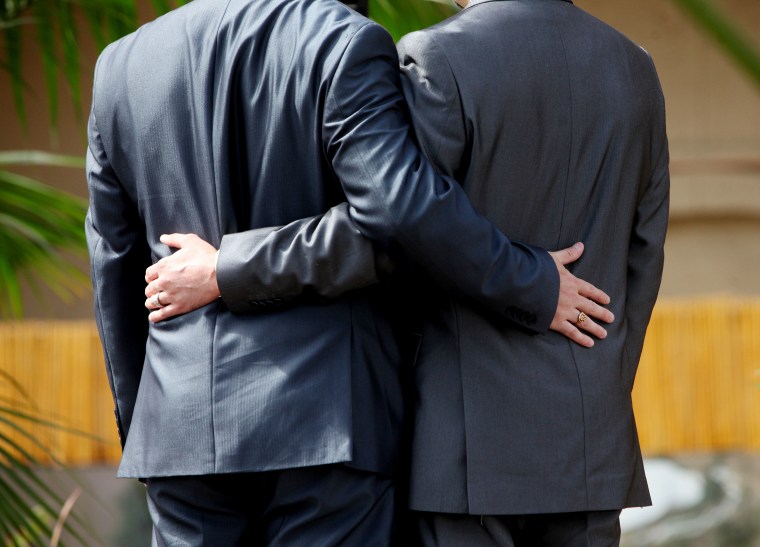As households across the United States start to receive their 2020 census packets, LGBTQ advocacy groups are ramping up efforts to ensure lesbian, gay, bisexual, transgender and queer people living in the country are counted and understand what’s at stake when it comes to the decennial survey.
“We want LGBTQ folks to know that census data are used to allocate political power,” said Meghan Maury, policy director of the National LGBTQ Task Force, which runs the Queer the Census campaign. The drive, formed just before the 2010 census, works to raise LGBTQ awareness and participation in the population count.
The organization’s efforts are increasingly important as the coronavirus pandemic sweeps the globe and upends the daily lives of people across the U.S. and beyond. This public health crisis has complicated the Census Bureau’s plans to deliver by year-end an accurate count of every person living in the country.
How are LGBTQ people counted?
As required by the Constitution, the census every 10 years will count all people living in the United States on April 1, 2020, and for the first time, same-sex couples are being explicitly counted.
The 2020 census asks respondents about their relationship to the person with whom they share their home, and now includes “‘opposite-sex husband/wife/spouse,” “same-sex husband/wife/spouse,” “opposite-sex unmarried partner” and “same-sex unmarried partner.” In previous surveys, the options were “husband and wife” or “unmarried partner.”
This change, the Census Bureau told NBC News in April 2018, was made to “better collect more detailed data about types of coupled households.”
Data on same-sex cohabiting couples, however, only provides a partial snapshot of the country’s LGBTQ community, as many individuals do not live with a same-sex partner.
“The data we get from the census won’t be representative of everyone in our community,” Maury said, who along with her organization has been advocating for higher LGBTQ participation in the count.
According to NBC News’ reporting from 2017, LGBTQ advocates pushed to add an explicit question about sexual orientation and gender identity, and they briefly rejoiced when a draft of the census was leaked in 2017 showing such a question. But soon after, the Census Bureau issued a statement saying that the question had been a “mistake.”
Even so, the LGBTQ data the 2020 census does collect will be useful, according to advocacy groups. Knowledge about the “number of same-sex couples that are raising kids, the geography of where same-sex couples live, and the race and ethnicity of people in same-sex couples” will all help policymakers better understand at least the cohabiting part of the LGBTQ community, Queer the Census said in a statement.
What’s at stake?
Census data is used to help allocate more than $675 billion in federal funding each year on everything from infrastructure to job training services, according to the Census Bureau. The data also helps determine a community’s emergency readiness needs and how many seats each state has in the House of Representatives.
This information is also used to disburse funds for programs such as the Supplemental Nutrition Assistance Program (SNAP), Medicaid and public housing, all of which Maury said “LGBTQ people are disproportionately likely to use.”
Maury said one of her organization’s biggest efforts revolves around educating LGBTQ people about the census. She said at-risk communities — including LGBTQ people, people of color, immigrants, those experiencing homelessness and people with low incomes — are “overwhelmingly undercounted in the census.”
The National LGBTQ Task Force has found that not only are at-risk communities undercounted, but also “privileged” and wealthy people are overcounted, which “reinforce[s] systems of power and oppression in this country.”
Where can I fill out the 2020 census?
All home addresses in the U.S. should soon receive a packet that contains a private code, which can be used to fill out the survey online at my2020census.gov. Those who are unable to fill out the questionnaire online, which the Census Bureau says will take 10 minutes on average, can request a paper questionnaire.
Households that do not fill out the census as required by law will be visited by an in-person census taker. Due to the coronavirus pandemic, however, the Census Bureau is delaying certain aspects of its survey collection and counting process. While online and mail collections are proceeding normally, census takers won’t go out into the field until May to knock on doors of homes whose residents haven’t yet filled out the survey. And the deadline for counting everyone in the U.S. has been delayed by two weeks, moving from the end of July to mid-August.
Data from the 2020 census is expected to be available to the public beginning in December 2021.




